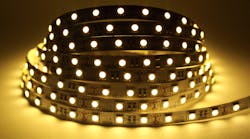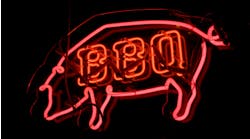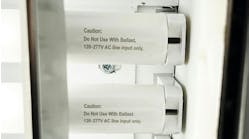In factories, lighting has traditionally been provided by grids of 277V fluorescent fixtures hanging overhead. This provides good ambient lighting, especially where things such as machines, panels, vertical I-beams, piping, HVAC ductwork, busway, and process materials don’t block the light and create shadows. The problem is, they often do block the light.
For electricians and other people involved in the maintenance and repair of the plant itself and the machinery in it, this means carrying a flashlight or stringing portable cords to set up portable work lights. And that can create multiple safety issues, including the need to “feel around” when working near energized equipment. One response is to add task lighting where the need is perceived, but this doesn’t always get done and isn’t always sufficient when it is done.
The grid system is easy to design and easy to distribute power to. What is not easy is moving a light fixture to where it would provide more of the light needed at one location without degrading the light at another location. Nor is it easy to provide non-glare task lighting or task lighting that is energy-efficient or has enough diffusion to avoid creating shadows, or ….
LED lighting solutions
If your workplace still has the traditional lighting grids, you don’t have to put up with holding a flashlight or running portable cords (and taping them down, etc.) to clunky portable lights. LED lighting provides multiple solutions.
One solution follows the portable cord/portable light model, but without the portable cord. Battery-powered LED portable lights have long run times and put out quite a bit of light. Many come equipped with hooks, magnets, or other means of affixing them to surfaces and positioning them to light up your work.
It is ideal for one-offs because you’re not spending time installing additional lighting. You’re sticking a portable work light to the metal panel next to you and pulling it off when you’re done.
Another solution follows the installed task lighting model. However, instead of running 120V to a floor fixture or a hanging lamp, you run 120V to an LED power supply and then distribute 5V power from it to the LED lighting system. That system does not have to resemble a single source of light that you have to fiddle with to get light where you need it and eliminate shadows. You could, for example, install an LED strip along each side of a cabinet. To see how well this can light the inside of an enclosure, look inside any modern refrigerator with LED interior lights.
This does not mean you should install LED strips at every panel, every time you go out to one that isn’t (yet) well lit. It means the conditions of lighting should be noted along with some dimensions for installing LED strips. Then a work order should be generated for each lighting project as it is approved.
For the inside of an enclosure, a limit switch can automatically control the light depending upon whether the door is open (lights needed) or closed (lights not needed). For many other situations, the LED sources can be combined with a motion detector so that nobody needs to find and flip a manual switch.
For example, you have four self-contained air compressor units and there are gauges on one side of each of them. You mount the strips at some overhead location and aim them at the gauges. A motion detector turns them on for 30 minutes; no more fumbling with a flashlight to write down the readings.
Can you think of other places where LED strips can improve safety and efficiency? Here are a few:
- At each fire extinguisher location. In a plant, this is typically on a vertical I-beam. A booster set could turn on based on a smoke detector signal.
- Along the floor as an exit path. These could be battery-powered and automatically turn on in case of a power failure.
- At first-aid kits. This is not only to help you find them but to be able to use them efficiently.
- As a frame around safety signs. For example, those requiring hearing protection to enter the area.
- As a lighting accent on the warning signs on electrical panels. This would warn of high voltage and so forth.
- At large motors. Lighting makes the nameplate easy to read and work inside the weatherhead.
- At inspection stations. In one plant, an operator using a micrometer had to carry the piece three feet to be able to take a reading because of shadows cast by all the equipment. Over-the-shoulder task lighting eliminated this.
- At blind corners. While an overhead mirror is often used to avoid personnel collisions at corners, people are often distracted or forget to look up. But if one side of the corner has a bank of bright LEDs aimed horizontally, the other side will see a shadow if someone is there. You have to choose which side for this to work.
All of this is possible because LED lighting comes in so many shapes and sizes. You can customize the installation to exactly what you need, and it’s inexpensive.




